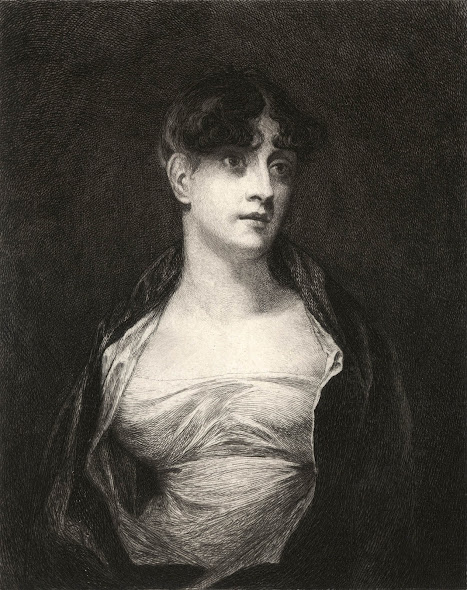Charles
Oliver Murray
(1842–1923)
“Mrs Scott
Moncrieff” (aka “Portrait of Margaritta Macdonald,
Mrs. Robert Scott Moncrieff [died 1824]” [NGS title]), 1879, after Sir Henry Raeburn’s (1756–1823) painting (c1814) in the National
Gallery of Scottland, published in 1879 by Seeley & Co in London in Philip
Gilbert Hamerton’s (1834–1894) (ed.), “The Portfolio: An Artistic
Periodical”, 1879, as an inset plate between pages 200 and 201.
Etching and
drypoint on wove paper with full margins as published.
Size: (sheet)
31.3 x 22.8 cm; (plate) 21 x 16.5 cm; (image borderline) 17.8 x 14.2 cm.
Scratch
lettered in plate below the image borderline: (left) “Raeburn Pinxt”; (right)
“C.O. Murray Sct.”
The National
Galleries of Scotland offer the following insights about this Raeburn’s
portrait:
“…one of
Raeburn's best-loved portraits, but virtually nothing is known of Margaritta
MacDonald's personality or life. She married Robert Scott Moncrieff, an
Edinburgh wine-merchant and friend of Sir Walter Scott. She died in 1824 and
her husband survived her for thirty years. During this time he kept her
portrait permanently in his dining-room, and never remarried. The dating of the
picture is a guess, based on stylistic grounds. In the last decade of his life
Raeburn changed his style, partly influenced by Rembrandt's art, and worked in
a more rounded manner, presenting forms in deliberate soft focus” (https://www.nationalgalleries.org/art-and-artists/5299).
This print is
described by the Ashmoleam Museum (Oxford): https://collections.ashmolean.org/object/193887.
From my reading
of Alexander Fraser’s account of Raeburn’s portrait in “The Portfolio” (1879),
I understand that the painting has “cracked considerably.” The reason for the
cracking is explained in part by Fraser’s idea that Raeburn may have used asphaltum
in the background. More contributing factors for the cracking may be Raeburn's technique of adding a glaze of egg white to the surface of the painting “to brighten
it”, after which a coat of mastic varnish was then applied over the egg glaze
by the sitter’s husband (see p. 200).
For those who
may be interested in Raeburn’s palette, I gleaned the following interesting
details from Fraser’s (1879) account of Raeburn:
“… his colours
were vermilion, raw sienna (but sometimes yellow ochre instead), Prussian blue,
burnt sienna, ivory black, crimson lake, white, of course, and the medium he
used was ‘bumption,’ a composition of sugar of lead, mastic varnish and linseed
oil.” (p. 202)
Raeburn’s
arrangement of these colours are as follows: “three tints of vermilion and
white, three tints of raw sienna, and three tints of Prussian blue, as well as
the three pure colours, but of black, burnt sienna, and lake, he mixed no tints.”
(Ibid.)
Condition: a
richly inked and well-printed, near faultless impression in pristine condition
with no tears, holes, folds, abrasions, losses, stains, foxing or signs of
handling.
I am
selling this small but glowingly radiant etching, for the total cost of AU$193 (currently US$142.02/EUR120.69/GBP102.37
at the time of this listing) including postage and handling to anywhere in the
world, but not (of course) any import duties/taxes imposed by some countries.
If you are
interested in purchasing this Rembrandtesque translation into line of one Raeburn’s
most famous portraits, please contact me (oz_jim@printsandprinciples.com) and I
will send you a PayPal invoice to make the payment easy.
This print has been sold












No comments:
Post a Comment
Please let me know your thoughts, advice about inaccuracies (including typos) and additional information that you would like to add to any post.